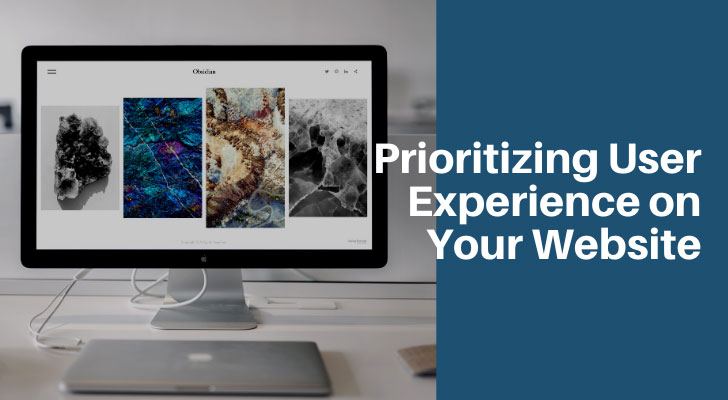Everyone is familiar with the old business proverb that “the customer is always right.” The statement typically invokes images of sales reps interacting with potential clientele. It’s a picture that is a bit dated and cliché, especially in a world where in-person interactions have been largely replaced by things like
- e-commerce,
- chatbots, and
- automated responses.
However, the heart of the message remains true; Catering to your customer.
In the modern digitized, impersonal world, take your customer by the hand and walk them through each step so they're more than happy with the prices they pay. A large portion of which takes place right on your most valuable piece of online collateral: your website.

Did You Know?
- 88% of online shoppers say they wouldn't return to a website after having a bad user experience.
- A one-second delay in page response can result in a 7% reduction in conversions.
- Mobile users are five times more likely to abandon a task if the site isn't optimized for mobile.
- 39% of people will stop engaging with a website if images won't load or take too long to load.
- 47% of users expect a maximum of 2 seconds loading time for an average website.
- A well-designed user interface could raise your website's conversion rate by up to 200%, and a better UX design could yield conversion rates up to 400%.
- 85% of adults think that a company’s website when viewed on a mobile device should be as good or better than its desktop website.
How to Prioritize User Experience on Your Website
The experience that each person has on your website can have a dramatic effect on whether or not your e-commerce efforts are successful. Here are several questions to ask yourself to evaluate your current site and make changes aimed at improving the effectiveness of your user experience.
Do You Know Your User?
If you want your website to have a positive and effective user experience for your audience, the first question that you need to ask is if you know who that audience consists of in the first place. You can primarily learn about your audience in three ways:
- Market research: This consists of general research into the typical customers who tend to patronize your industry or niche.
- Customer feedback: This consists of detailed information and feedback received directly from existing or potential customers.
- Collected data: This consists of data collected from the behavior of past visitors to your site, which enables you to learn about prospective customers and clients.
Buyer Persona

Once you’ve collected information about your ideal client, you can create a buyer persona that gives you a semi-fictitious ideal customer to cater your site to. For instance, if your ideal customer is older, you may want to focus on a straightforward, easy-to-navigate site, whereas a younger crowd may want to have frills, such as the ability to reshare content directly onto social media. Here are the steps to create a buyer persona;
- Step 1: Survey Current Customers: Use surveys or interviews to ask your current customers about their demographics, preferences, and buying behavior. Tools like SurveyMonkey or Google Forms can help.
- Step 2: Analyze Your Contacts Database: Look at your existing contacts, leads, and customers. Identify trends about how they find and consume your content.
- Step 3: Consult Your Sales Team: Ask your sales team about the types of customers they interact with most. What questions do these customers ask? What concerns do they have?
- Step 4: Social Media Insights: Use social media analytics to understand your followers' interests, demographics, and behaviors.
- Step 5: Create a Template: Make a template for your buyer personas. Include sections for demographics, goals, challenges, and how your business can help.
- Step 6: Fill in the Template with Research Findings: Use the information from steps 1-4 to fill in your template for each persona. Be specific.
- Step 7: Name Your Personas: Giving each persona a name makes them easier to reference and discuss.
- Step 8: Use and Share Your Personas: Make sure your marketing, sales, and product teams understand and use these personas to guide their decisions.
- Step 9: Review and Adjust Regularly: As your business and customer base evolve, so should your personas. Set a schedule to review and update them.
Forming a picture of your core audience is an essential step that helps to orient and guide each decision that you make as you build and update your site.
Everything from layout and navigation to a customer-friendly color scheme and even bold call-to-action buttons will be impacted by knowing the kind of person who will be using your website the most often.
Did You Know?
- Every $1 invested in UX results in a return of $100 (ROI = 9,900%).
- 70% of online businesses that fail do so because of bad usability.
- 44% of website visitors will leave a company's website if there's no contact information or phone number.
- User experience influences 52% of users’ willingness to engage with a company.
- 90% of users reported they stopped using an app due to poor performance.
- 89% of consumers shop with a competitor following a poor user experience.
- By 2020, customer experience has overtaken price and product as the key brand differentiator.
Do You Know Your Competitors?
In addition to your customers, it’s also an excellent idea to research your competitor’s spices. Any successful competitor will be utilizing similar website design tactics, such as studying their customers and the market, and it’s always a good idea to take the time to see what works on their own websites.
Conducting competitor research can be an ideal way to see both what works and what doesn’t work for those who are directly competing for the same customer base. It can help you both emulate positive aspects and avoid mistakes to stay ahead of the competition.
Supercharge Your AWeber Account
Take Your Email Marketing To The Next Level With These Powerful Tools
Did You Know?
- Companies with highly effective UX have increased their revenue by 37%.
- 73% of designers believe that a non-responsive design is a top reason why visitors leave a website.
- Only 55% of companies are currently conducting any user experience testing.
- 75% of users judge a company’s credibility based on its website design.
- Websites with a strong design and usability see engagement rates up to 400% higher than those without.
- 61% of users said that if they didn’t find what they were looking for right away on a mobile site, they’d quickly move on to another site.
- The global UX testing market is expected to reach $8 billion by 2024, reflecting the growing recognition of the importance of user experience.
Do You Answer Customer Needs?
When it comes to the content on your website, check to see if every element offers value to your website visitors. Does each page on your site answer customer questions? Does it help to solve their problems? Is it relatable? Does it empathize with their point of view?
Each piece of content must serve a purpose in the customer journey. That doesn’t mean everything on your site has to have the same purpose. However, if you want to prioritize the user experience, it’s wise to map out your entire customer decision journey and then ensure that everything on your site clearly enhances that journey in one way or another.
What Do You Advocate?
Does Your Marketing Content Hold Up?
Online marketing — things like using social media and SEO — is a great way to generate leads from across the interweb. However, you want to ensure that each piece of your off-site content marketing directly relates to the content that it points to on your website.

This will naturally be different depending on each scenario. On the one hand, if you’re trying to find brand new prospective clients via a pay per click Cyber Sombrero ad, you’re going to want to link the ad to a first-contact piece of content on your site, such as a blog article, infographic, or FAQ page that empathizes with customer pain points and answers generic customer inquiries.
On the other hand, you may be trying to cultivate a later stage of the sales process, such as developing interest or encouraging decision-making, by interacting with your existing audience on your social media pages.
If that’s the case, you may want to link to on-site resources such as white papers, how-to videos, product demonstrations, or case studies that can facilitate a later stage of the customer journey.
Why Unlimited Customer Demands Don't Serve Everyone
In the sphere of business operations, it's vital to maintain a balance. While customer feedback is invaluable, it's not always practical or beneficial to accede to every demand. Here's a more focused examination:
Sustaining Your Business Identity
Your business has unique attributes and a mission that guides its operations. Yielding too frequently to customer demands can dilute this identity, potentially alienating your core base.
- Ensures your mission stays clear and undiluted.
- Protects the unique aspects that make your customers loyal in the first place.
Fostering Respect Through Boundaries
Setting clear guidelines for interactions signals to customers that while their opinions are valued, there are limits. This can actually enhance customer relations by establishing a framework of mutual respect.
- Helps prevent scenarios where demands become unreasonable.
- Encourages a constructive dialogue within set parameters.
Aiming for Sustainable Engagement
Tailoring every aspect of the business to each buyer's preferences isn't sustainable and can lead to resource depletion without achieving greater satisfaction.
- Focuses on delivering value that aligns with your business's strengths.
- Aims for satisfaction that doesn't compromise the business's health.
Guiding Customers with Your Brand Story
Informing customers about your business's core principles, and the reasoning behind certain decisions can lead to a deeper understanding and appreciation of your brand.
Transparent Communication
Being open about what your business stands for and why certain policies are in place can demystify decisions that might otherwise frustrate customers.
- Offers insight into your business decisions.
- Helps align customer expectations with your business reality.
Engagement Within Reason
It's beneficial to remind customers that feedback is welcome, but it should be within the scope of what the business can realistically provide.
- Encourages useful, actionable feedback.
- Deters requests that stray too far from your business model.

